DAY 160 – EXPLORING WHYALLA
A lovely day in Whyalla today… The sun is shining, the rain has gone and
even the wind has died down. We have a
pretty full day of sightseeing to do in Whyalla today…
First things first though, we needed to
do a quick load of washing, so once that was done and hung out, Steve and I
went to explore Ada Ryan Gardens.
Ian and Kathy hadn’t been up to Hummock
Hill, so they decided to go visit the lookouts and then we would meet up at
lunch time and go visit the Whyalla Maritime Museum and do the tour of the HMAS
Whyalla together…
The Ada Ryan Gardens are a memorial to
the foresight of the early Whyalla city fathers, and is one of the most popular
parks in Whyalla. It’s location helps to
make it this as it is linked to the foreshore to provide a large relaxing park
area.
The gardens have lovely manicured lawns
and gardens, free BBQs and picnic tables, bird aviaries, a duck pond, and a
small zoo. There are lovely paved
pathways throughout and we enjoyed the morning wandering through the gardens.
 |
| Very unusual peacock with a white bib and a display of white feathers |
One of the highlights of our visit here
was an unusual peacock, which put on a lovely display of his plumage for
us. He was quite unusual in that he had
a bit bib under his beak, and all his centre tail feathers were white. I have never seen a peacock like this before
and we were able to get some good photos…
 |
| He would say hello and shake his head at us |
There were also lots of friendly caged
galahs who were happy to say hello to us and shake their heads, and they also
had the most adorable white rabbit with pink ears. Willow would have loved it…..
 |
| Plenty of sea grass washed up on the beach |
 |
| Even the dolphins had come in to visit us.... |
From the Gardens, we drove back down to
the Marina so that Steve could go for a walk out along the stonewall. Seriously, he wanted to check for fishing
spots down there. He was pretty sure
there must have been fish in there as there were quite a few dolphins cruising
around. We all know that dolphins are
anywhere where there is fish…
.Then, it was a quick dash back to the
caravan park to bring in the washing and have a bite to eat before meeting up
with Ian and Kathy out at the Whyalla Maritime Museum to do a tour of the HMAS
Whyalla.
The Whyalla Maritime
Museum is home of the former HMAS Whyalla - first ship built at the Whyalla
Shipyard in 1941.
We arrived just in time for the tour and loved
it. Our tour guide was passionate about
Whyalla and the HMAS Whyalla, and made the tour very interactive, and hands on
for us. We were able to photograph each
other being entertained with the various activities such as steering the ship,
both from the emergency steering wheel and the main wheel, ringing the bell and
horn, and sitting on the cannon seat all whilst our guide ran through the
history of this great ship.
 |
| And the boys talk about girls going to the Loo together, on the ship there were two loos in the same room. |
The HMAS Whyalla, named after the city of Whyalla, was built in 1941 and was the first to be built in the Whyalla shipping yards. The ship was one of 60 Bathurst-class corvettes built for World War II and received three battle honours for her wartime service. She was decommissioned in 1946 when she was then sold to the Victorian Public Works Department and renamed “Rip” and was used as a lighthouse maintenance vessel in Port Phillip Bay.
In 1984 she was set to be sold for scrap
and when the town of Whyalla heard of this they negotiated to buy her back for
$5000! They would have received a lot more for scrap metal money than
that! After sailing back to Whyalla it then cost more
than $200,000 to relocate her 2km inland in 1987, where special footings
were made for her to sit on. She now holds the prime spot in the Museum gardens
and is such an amazing sight to see.
The museum located behind the ship
goes further into detail about the vessel and others made in Whyalla and also
hosts some very significant pieces of maritime history such as Matthew Flinders
Journal and Charts. The model railway located inside the museum is also an
interesting viewing experience as it is one of the largest HO gauge
model railways. It depicts the links between One Steel in Whyalla and Iron Knob
to Port Augusta to Adelaide. We also
enjoyed watching the 20 minute film on the relocation of the ship.
There is honestly so much to see in this
museum and when combined with the tour of the HMAS Whyalla, it was easy to spend most of the afternoon
here. We probably would have spent a lot
more time there too if we weren’t wanting to go out to Point Lowly to see the
Lighthouse….

 |
| Camping area at Point Lowly - at only $8 per night |

The white Point Lowly lighthouse was
built in 1876 and is Whyalla's oldest
building and sits at the top of a very rocky outcrop of land at Point Lowly.
The lighthouse and it's adjacent lighthouse keepers cottages are now owned by
the Whyalla City Council and are
heritage listed. The keepers cottages are also now available for rent and there
are even caravan and camping facilities available out here with clean toilets
and cold showers for just $8 per night.
A dodge tide happens once a fortnight and for a day or two each time, there is no tidal movement at all.
The lighthouse was manned by lighthouse keepers for 90 years, the beacon was a guiding light for the ships heading up the gulf to Port Augusta and Port Pirie. The lighthouse became automated and then was delisted altogether after the Australian Maritime Safety Authority thought it not important enough and too expensive to maintain. In February 1993 the lighthouse light was turned off.
Thankfully, the Whyalla Council thought
differently and with the support of the Government of South Australia,
purchased the lighthouse. The light was re-activated and the lighthouse was
back in operation in March 1995. The light now shines brightly every night.
Port Lowly is also famous for being the world’s largest cuttlefish mating and
breeding ground in the world.
Unfortunately we missed seeing these giant cuttlefish as the breeding
time is from May to August. Tens of
thousands of giant cuttlefish arrive in the 10km area between Fitzgerald Bay
and False Bay each year and has become quite a tourist attraction for Whyalla.
What we didn't expect to see on the 20 minute drive in from the main road was a massive fracking processing plant at Port Bonython as well as the Australian Defence Force's 2100 square kilometre army weapon training area. Both are just a few minutes’ drive from Point Lowly.
What we didn't expect to see on the 20 minute drive in from the main road was a massive fracking processing plant at Port Bonython as well as the Australian Defence Force's 2100 square kilometre army weapon training area. Both are just a few minutes’ drive from Point Lowly.
When we were looking for things to do in
Whyalla, I had read about the Shingle Beach Ridge and we found this in
Fitzgerald Bay on our way back from Point Lowly.
This is another unique geological
feature of the area which run for a
distance of about 50kms from near the head of the Spencer Gulf southward along
its western shore to Stony Point. It has
been provisionally entered for inclusion as a State Heritage place in South Australian
Heritage Register as there are only two other places in the world registered
with similar Shingle Ridges being in Egypt and Scotland.
Consisting of moderately sorted,
rounded to sub-angular pebbles and cobbles, the deposits form sinuous, flat topped
and well preserved ridges 3-5 metres above present mean sea level.
Most are usually narrow – no more
than 10-15 metres wide. In some areas the deposits form cliffs behind the
modern beach.
The movement of gravel by present
day waves in the northern part of Spencer Gulf is restricted compared with that
indicated by the ridges. It appears that the combination of a high sea level (3
metres higher than today), strong easterly winds, and high wave energy
dissipation along the shore line, were responsible for the deposits.
We found them interesting, but
more so because it hid the free camping strip along this foreshore of the
bay. We drove through one of the
cuttings in the ridge and noticed that there were probably 20 or more caravans
an campers camped in here…. Must make a note for next time we travel down this
way.
Our last stop off on our way home
was a little detour into False Bay… It was a very shallow bay where the water
receded a long way at low tide. Steve
was checking it out as a possible fishing spot for whiting… but after taking a
photo for me, he noticed a lot of sea grass deposits and started digging for
some worms, when he noticed heaps and heaps of these fibrous like spongy
cocoons. They were scattered all over
the beach and through the sea grass everywhere.
We are still not sure what they are.
He did break one open but fibrous right through. Pretty amazing….
Time to head back into town as there were still a couple of other places we wanted to see before heading home. I particularly wanted to see "The Loaded Dog" as this was one of the Henry Lawson stories I have read with my year 6 students back home as a selected reading piece...
The dog was the inspiration of Dr. Andrew Melville-Smith, the principal veterinarian at the Whyalla Veterinary Clinic and was sculpted by world famous sculptor, Andy Scott , in Glasgow Scotland. The dog is a spectacular steel sculpture about the size of a small horse and was sculpted by the world famous sculptor Andy Scott in Glasgow, Scotland using his unique technique of wielding of thousands of tiny pieces of steel rod to create iconic street art.
The Loaded Dog statue is based on the dog, Tommy, from Henry Lawson's famous Australian story called The Loaded Dog. The story revolves around a mischievous Labrador Retriever dog who picks up an explosive charge, jumps through the camp fire lighting the fuse and the chaos that follows when his owners, Andy and Dave, try to get the explosive charge back before it detonates.
Time to head back into town as there were still a couple of other places we wanted to see before heading home. I particularly wanted to see "The Loaded Dog" as this was one of the Henry Lawson stories I have read with my year 6 students back home as a selected reading piece...
The dog was the inspiration of Dr. Andrew Melville-Smith, the principal veterinarian at the Whyalla Veterinary Clinic and was sculpted by world famous sculptor, Andy Scott , in Glasgow Scotland. The dog is a spectacular steel sculpture about the size of a small horse and was sculpted by the world famous sculptor Andy Scott in Glasgow, Scotland using his unique technique of wielding of thousands of tiny pieces of steel rod to create iconic street art.
The Loaded Dog statue is based on the dog, Tommy, from Henry Lawson's famous Australian story called The Loaded Dog. The story revolves around a mischievous Labrador Retriever dog who picks up an explosive charge, jumps through the camp fire lighting the fuse and the chaos that follows when his owners, Andy and Dave, try to get the explosive charge back before it detonates.
As the Mount Laura Homestead was
just around the corner from “The Loaded Dog”, we thought we would drive by and
check it out.
The Mount Laura Homestead Museum
is a complex of buildings including 1922
sheep station homestead telling the story of the early days of Whyalla, an
original BHP workman’s cottage of 1914, an engine shed and the
Telecommunications Museum with a range of historic items from the overland
telegraph era to modern satellite communications.
It was closed for the day, so we
were unable to go through the complex, although we were able to have a walk
around their grounds and gardens. I
think it would be a good place to visit if you are in Whyalla. It looked like there was plenty to do and see
there.
Time to head home; it was close to
7pm… it doesn’t seem that late as the sun doesn’t set now until after
8.30pm. It is easy to get carried away
with our sightseeing when the days are so long….
 |
| Right on the beach in Whyalla |
 |
| Our site |
We are off again in the morning…
Off to Port Augusta, our last stop together.
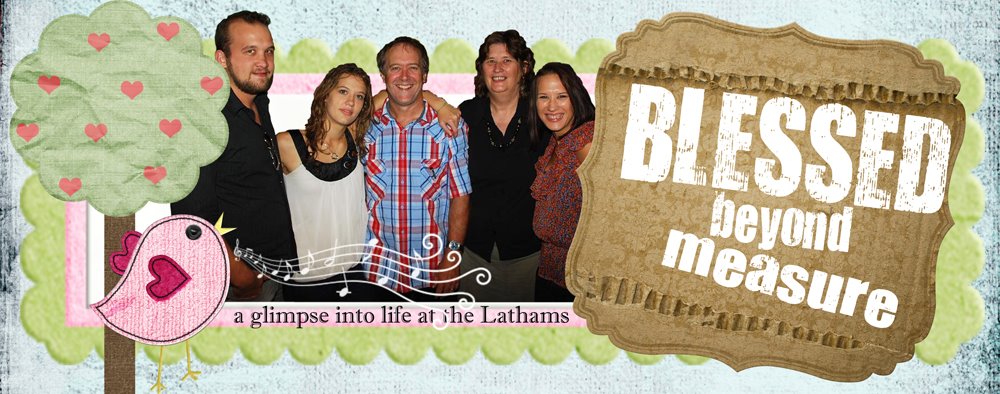








































































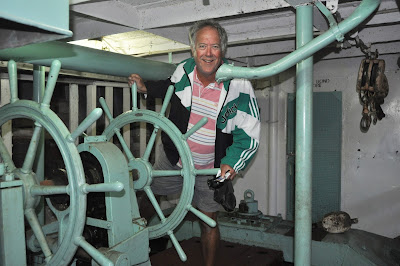































































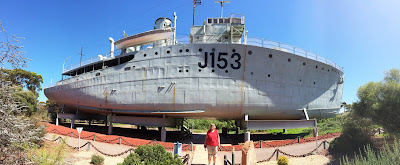














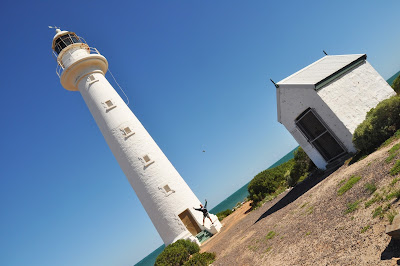




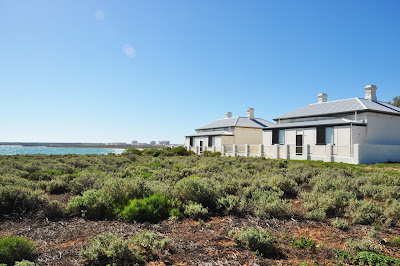





















































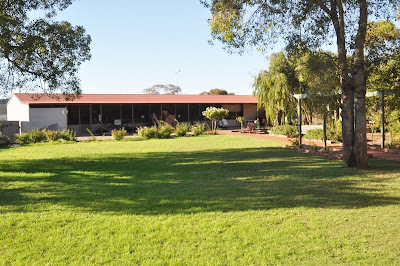











0 comments:
Post a Comment